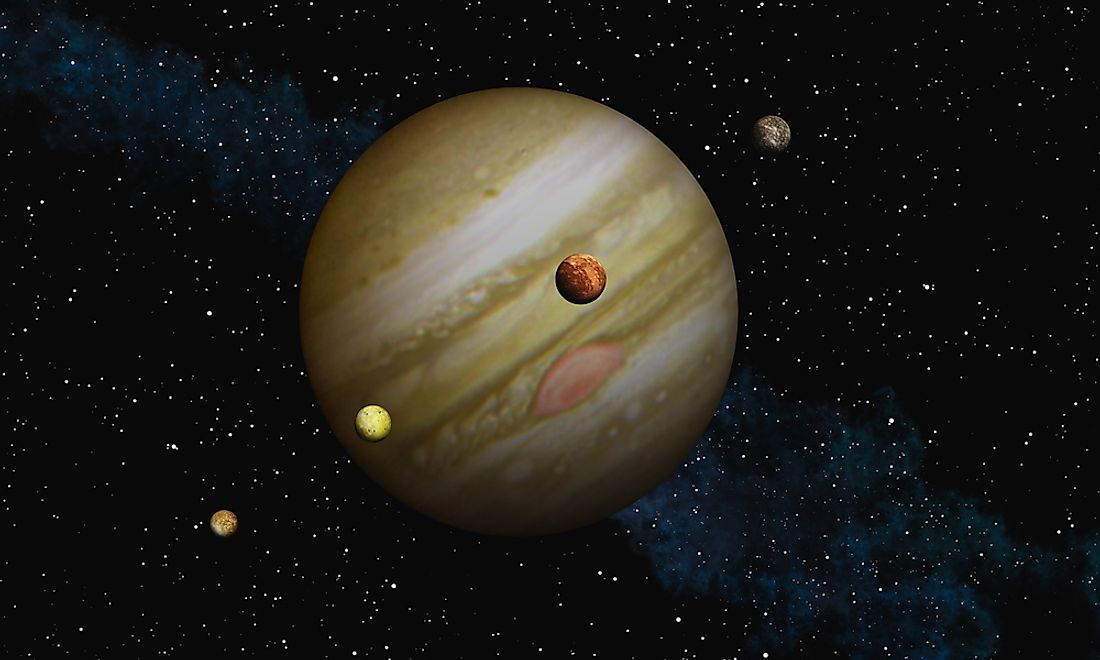– * Unique moons of the wonderful Jupiter *
In some there is only snow and in some there are hundreds of active volcanoes and lava.
– * red spot is still a puzzle for astronomers *
* Recent research of the temperature of the evergreen beautiful aurora has surprised *
Jupiter i.e. Jupiter, whose mythological and scientific aspects we have already told in this chapterWhen Galileo first saw its four moons with his telescope, other astronomers and people who persisted in the old opinion refused to believe that there could be other moons in the universe besides our moon and those Four of the moons that Galileo first saw and discoveredToday the moon is also called *Galileo’s moon*. Astronomers have so far discovered 80 moons that orbit Jupiter. And along with the giant Jupiter, its four moons are also known for their vastness. These four moons are Ganymede, Io, Europa and Callisto.
*Jupiter’s moon is covered with ice and has active volcanoes*
Jupiter has four moons, in which three moons are bigger than our (Earth) moon. Ganymede, which is larger than the planet Buddha (4850 km) in diameter. The first *Io* in the Galileo moon, whose diameter is 3600 km, is closest to Jupiter. It completes the orbit of Jupiter in about 43 hours. The special thing about this moon is that hundreds of very active volcanoes have been seen in it. These volcanoes continuously emit a liquid sulfur, the reason for which is not yet clear, scientists are researching in it. The second moon is Europa, which is the smallest of Galileo’s moons. Its diameter is 3100 km, and it is covered with ice cover. Scientists believe that there may be a deep and vast ocean of water under the ice, in which the existence of micro-organisms can also exist. To know its secrets and find the possibility of life, NASA’s spacecraft *Juno* had reached near Europa on 30 September 2022 and sent close pictures of it to Earth, after whose research the secrets are yet to be revealed.
The third moon is * Ganymede * which is the largest moon in the solar system, its diameter is 5260 km. Which is a big body of ice and rocks. The fourth Galileo moon is Callisto, its diameter is 4800 km. This too is a ball of ice and rock. Jupiter’s other moons are smaller. Our ie Earth’s moon revolves around the Earth from a distance of about four lakh km (400000), while the last few moons of Jupiter revolve around Jupiter from about 25 million km away. And a special thing about the last moons of the far distance is that they revolve around Jupiter in the opposite direction. Other things about its moons are also amazing, which can be studied only by reaching close to them, astronomers are striving for it. Currently, after Juno, NASA’s Clipper mission will visit Europa in 2024 and send other information to Earth.
*Jupiter’s red spot still unsolved puzzle*
Due to being far away from the Sun, the temperature of the Sun reaches very little in Jupiter, so the temperature of its atmosphere remains below minus 150 degree centigrade. Its atmosphere is very dense. Looking at Jupiter with binoculars, we have seen only many red-brown and pink bands of it, which are the storms of its dense atmosphere, which have been increasing in the travel path without stopping over the years. Along with this, there is a * huge red-pink colored spot * in the southern hemisphere of Jupiter, which has become a unique identity of it. It was discovered in 1665 and was first seen in 1830. This spot is 40000 km long (forty thousand) and fourteen thousand km 14000 km wide, but it keeps on moving and moving as well as moving from its place. Only this spot in Jupiter is so huge that three Earths like ours can easily fit in it. Scientists are still trying to solve the riddle of this spot. It is also believed that this box is a big cyclone storm that arose in Jupiter. There is also another small red spot near this huge stain, which was previously seen in yellow-white color, but during 2006 research it is rapidly changing to red color.
*Identity of the evergreen beautiful Aurora Jupiter*
In the polar regions of our earth, the beautiful sights of beautiful aurora are rarely seen (during the solar flare), whereas these auroras are always evergreen in Jupiter. Which is of the polar regions that form Jupiter’s auroraTemperature.
In recent research, it has come to the fore that the temperature of its polar regions is 700 degrees Celsius, while the temperature in the polar regions should be minus. At the same time, due to being far away from the Sun than the Earth, the heat of the Sun reaches very little there. Due to which the temperature of its atmosphere is about 150 degrees Celsius below zero. Due to its dense atmosphere, we can only see its outer atmosphere. Nevertheless, scientists are trying to study it closely and are constantly carrying out new efforts.
* Close exploration of Jupiter and its efforts to land on the moon *
The exploration of this fifth giant planet of the solar system with spacecraft has started. The Pioneer-10 vehicle, sent from Earth in December 1973, passed close to Jupiter and moved forward. Pioneer-11 was dispatched the following year. In 1979, two Voyager vehicles passed close to Jupiter and went ahead, these vehicles collected a lot of information about Jupiter and its moons and sent it to Earth. The Galileo vehicle, sent mainly for the study of Jupiter, was sent towards this planet in 1993. Which reached close to it in 1995 and brought the information to the earth. There is also a special thing about Jupiter that here too, like Saturn, there is a beautiful ring in this planet as well. Which was discovered in a picture sent to Earth by Voyager-1. Then Voyager-2 confirmed the ring around Jupiter. Juno, sent in 2011, has recently reached its moon on 29 September 2022 and sent its information to Earth. In 2024, NASA’s Clipper vehicle will visit Europa and will reveal new secrets. In this way, the process of reconnaissance of Jupiter has started, if man wants to reach here in the near future, then only its moon can land in Europa. Late in the morning man will land in this or other moon and will also try to land in the atmosphere of the largest planet of the solar system only when the secrets close to it will open and favorable conditions will be found.
* It is such a wonderful Jupiter, its moon is unique, its evergreen aurora is its identity, where the temperature exceeds 700 ° C, while in the atmosphere it is close to minus 150. There is an ocean of ice water and rocks in the moon, while there are hundreds of active volcanoes and their lava.
Article – Bablu Chandra. Photo WoldAtlas
Source-universe introduction

Journalist Space science.
Working with India’s leading news paper.
और अधिक जानें

